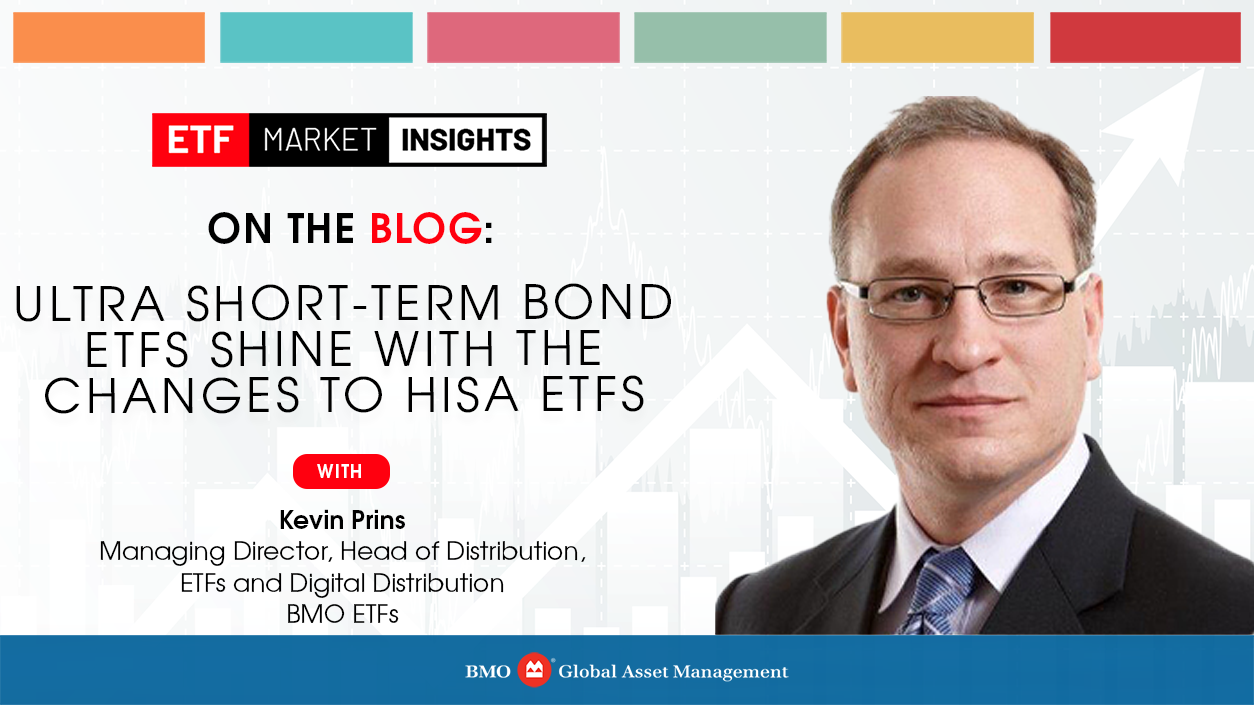
Seemingly boring cash has become anything but in recent years, growing into a vibrant corner of the Canadian market in the wake of regulatory developments, new product launches and substantial asset gathering amid rising interest rates.
“Cash alternative” ETFs that primarily invest in deposit accounts at Schedule I Canadian banks (High-Interest Savings Account, or HISAs) and money-market ETFs that invest in ultra-short-term fixed income securities have soared in popularity for their low risk profile, attractive yield, and daily liquidity—providing a safe harbour to park idle cash during market stress.
No less than $10 billion poured into HISA ETFs and ultra-short term bond vehicles in 2023 alone, increasing overall assets under management in the segment to $30 billion.1
Yet for HISA ETF investors, the Office of the Superintendent of Financial Institutions (OSFI) has thrown some cold water on returns, recently clamping down on concerns that the large flows could cause undue volatility should the trend unwind in an unruly way—effectively eliminating their yield advantage over comparable fixed-income options.
OSFI’s decision requires financial institutions to classify deposits from cash alternative ETFs as if they might fully “run off” akin to wholesale or institutional funding. The result has been (as expected) a tumbling of yields by between 20-50 basis points (bps).2
While we expect cash will continue to experience strong flows, the OSFI ruling has left those vehicles with no yield advantages over traditional money market ETFs, like the BMO Money Market Fund ETF Series (ticker: ZMMK) and BMO USD Cash Management ETF (USD Units) (ticker: ZUCM.U).
Ultra-short-term bonds will also likely become the choice for those investors who want an additional yield pick up over money-market instruments. The BMO Ultra Short-Term Bond ETF (ticker: ZST) and the BMO Ultra Short-Term US Bond ETF (USD Units) (ticker: ZUS.U) represent attractive alternative exposures.
In what was likely a reaction to the OSFI decision and its uncertain impact on yields, inflows to cash alternative ETFs slowed materially in 2023. With comparable liquidity, yield and risk metrics, some investors turned to money market ETFs like ZMMK to park cash.
How We Got Here
In 2022, OSFI commenced a review of banks’ Liquidity Adequacy Requirements (LAR), including the liquidity characteristics of cash alternative ETFs. The aim of the report was to “ensure banks have appropriate treatment and are managing liquidity risk effectively.”
After consulting with industry members and at least one deadline extension, OSFI announced a new requirement for financial institutions to classify deposits from cash alternative ETFs as if they might fully “run off” with more strict liquidity considerations to address the potential risk of heavy redemptions.
Prior to the review, most banks classified cash alternative ETFs’ deposits as stickier assets with a lower run-off rate. Treasury departments are able to offer higher yields on retail deposits compared to wholesale, considering the lower liquidity stress. The OSFI decision has ended that practice as of January 31, 2024.
The implication of this change means that banks must offer lower rates to ETF providers, and cash alternative ETFs’ yields have subsequently declined by roughly 20-50 bps.
The diminished yield profile has left investors looking for alternative options to shore up their short- and ultra-short public fixed-income exposures while maintaining a comparable yield to what they had been previously receiving.
BMO’s Ultra Short-Term ETFs vs. HISA ETFs
With a weighted average yield to maturity of 5.27%3, ZST is one such alternative. For U.S. dollar exposure, there is also the ZUS.U, with a current weighted average yield to maturity of 5.69%.3
ZST and ZUS.U are designed to provide exposure to high-quality corporate bond portfolios with a term to maturity of less than one year. The Funds primarily invest in investment-grade corporate bonds and have the ability to have exposure to government bonds and Treasury Bills for enhanced downside protection. The objective is to hold these bonds to maturity within the Funds and provide unitholders with monthly distributions.
Currently bonds in both Funds are trading at a discount as a result of rapid interest rate increases repricing bonds below par. The portfolio is able to enhance returns via the ability to earn capital gains as those bonds mature back to par value. This allows for capital gain treatment for tax purposes rather than solely interest income. In contrast, HISA ETFs are invested in a basket of savings accounts with Canadian banks. They offer no duration4 exposure and pay monthly distributions. Since the ETFs are invested in cash, all the distributions will be treated as interest income for tax purposes with no ability for capital gains preferential tax treatment.
Further, since bond yields and bond prices are inversely related, with interest rate cuts in Canada and the United States expected to occur in 2024, the underlying bond holdings should benefit from some duration exposure. This means that bond prices (and the Net Asset Values of ZST and ZUS.U) may provide a buffer against lower yields.
HISA ETFs will not be able to offer any buffer against lower interest rates as they only hold savings accounts and have no duration exposure. With the current geopolitical uncertainty and upcoming U.S. presidential elections, investors may seek to keep some cash on hand to take advantage of potential mispricing in the market. With the diminished return potential from HISA ETFs, investors can remain liquid while maintaining a competitive yield in vehicles like ZST and ZUS.U.
1 Bloomberg, as of December 31, 2023.
2 “Review of Cash Alternatives and Money Market ETFs in Canada,” National Bank Financial, February 28, 2024.
3 As at April 19, 2024. Weighted Average Yield to Maturity: The market value weighted average yield to maturity includes the coupon payments and any capital gain or loss that the investor will realize by holding the bonds to maturity. Annualized performance as of March 28, 2024: ZST 1 year (5.44%), 3 year (2.64%) and 5 year (2.29%), since inception (1.97%) and ZUS.U 1 year (5.35%), 3 year (2.44%), 5 year (2.01%) and since inception (1.98%).
4 Duration: A measure of the sensitivity of the price of a fixed income investment to a change in interest rates. Duration is expressed as number of years. The price of a bond with a longer duration would be expected to rise (fall) more than the price of a bond with lower duration when interest rates fall (rise).
Disclosures:
Any statement that necessarily depends on future events may be a forward-looking statement. Forward-looking statements are not guarantees of performance. They involve risks, uncertainties and assumptions. Although such statements are based on assumptions that are believed to be reasonable, there can be no assurance that actual results will not differ materially from expectations. Investors are cautioned not to rely unduly on any forward-looking statements. In connection with any forward-looking statements, investors should carefully consider the areas of risk described in the most recent prospectus.
The viewpoints expressed by the authors represents their assessment of the markets at the time of publication. Those views are subject to change without notice at any time without any kind of notice. The information provided herein does not constitute a solicitation of an offer to buy, or an offer to sell securities nor should the information be relied upon as investment advice. Past performance is no guarantee of future results. The statistics in this update are based on information believed to be reliable but not guaranteed.
This article is for information purposes. The information contained herein is not, and should not be construed as, investment, tax or legal advice to any party. Investments should be evaluated relative to the individual’s investment objectives and professional advice should be obtained with respect to any circumstance.
Commissions, management fees and expenses all may be associated with investments in BMO ETFs and ETF Series of the BMO Mutual Funds. Please read the ETF facts or prospectus of the relevant BMO ETF or ETF Series before investing. The indicated rates of return are the historical compounded total returns including changes in share or unit value and the reinvestment of all dividends or distributions and do not take into account the sales, redemption, distribution, optional charges or income tax payable by the unitholder that would have reduced returns BMO ETFs and ETF Series are not guaranteed, their values change frequently and past performance may not be repeated.
For a summary of the risks of an investment in the BMO ETFs or ETF Series of the BMO Mutual Funds, please see the specific risks set out in the prospectus. BMO ETFs and ETF Series trade like stocks, fluctuate in market value and may trade at a discount to their net asset value, which may increase the risk of loss. Distributions are not guaranteed and are subject to change and/or elimination. BMO ETFs are managed by BMO Asset Management Inc., which is an investment fund manager and a portfolio manager, and a separate legal entity from Bank of Montreal.
ETF Series of the BMO Mutual Funds are managed by BMO Investments Inc., which is an investment fund manager and a separate legal entity from Bank of Montreal.
BMO Global Asset Management is a brand name under which BMO Asset Management Inc. and BMO Investments Inc. operate.
®/™Registered trademarks/trademark of Bank of Montreal, used under licence.



















































